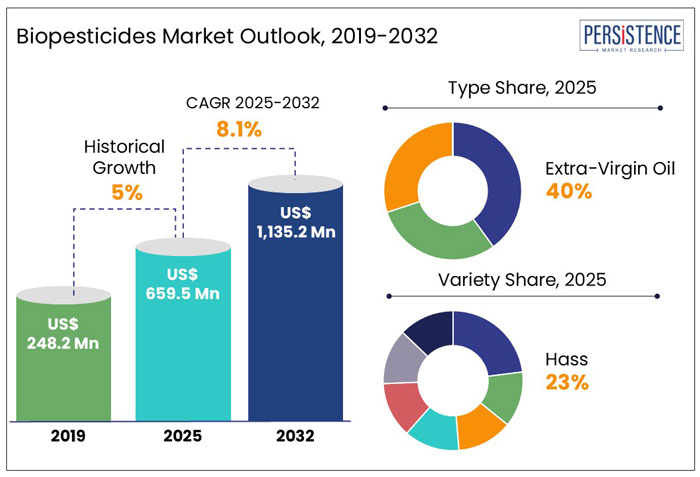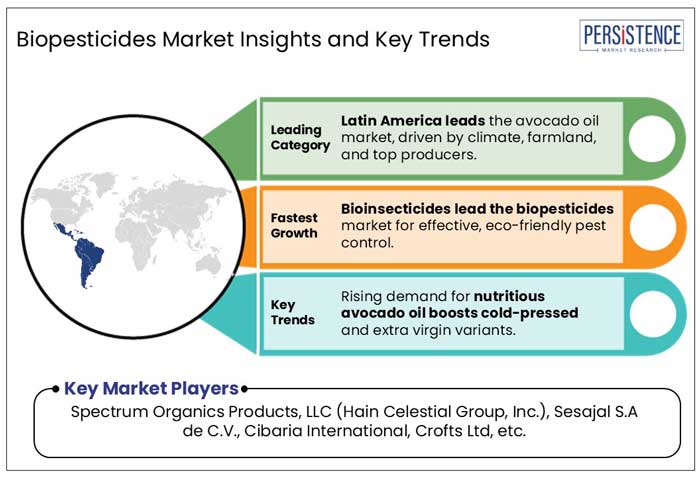Industry: Food and Beverages
Published Date: March-2025
Format: PPT*, PDF, EXCEL
Delivery Timelines: Contact Sales
Number of Pages: 303
Report ID: PMRREP3797
The Global Biopesticides Market is expected to grow from US$9,892.3 Mn in 2025 to US$19,771.6 Mn in 2032, at a substantial CAGR of 10.4% from 2025 to 2032.

|
Global Market Attributes |
Key Insights |
|
Biopesticides Market Size (2025) |
US$ 9,892.3 Million |
|
Projected Market Value (2032) |
US$ 19,771.6 Million |
|
Global Market Growth Rate (2025-2032) |
10.4% CAGR |
|
Market Share of Top 5 Countries |
54.2% |
According to Persistence Market Research analysis, the global biopesticides market is experiencing significant growth, driven by the increasing demand for sustainable and eco-friendly agricultural solutions. Biopesticides, derived from natural materials such as plants, bacteria, fungi, and certain minerals, offer an environmentally friendly alternative to conventional chemical pesticides. Rising consumer awareness regarding food safety, coupled with the growing demand for organic produce, is fueling the adoption of biopesticides in agricultural practices.
The global biopesticides market has experienced significant growth over the past few years, driven by increasing consumer demand for organic and chemical-free food products, stringent government regulations against synthetic pesticides, and growing environmental concerns. From 2019 to 2024, the market witnessed a steady compound annual growth rate (CAGR) of approximately 13% to 15%, primarily fueled by the rising adoption of bio-based crop protection solutions in agriculture.
The global biopesticides market is projected to expand at a significant CAGR from 2025 to 2032, potentially surpassing a valuation of US$ 19,771.6 million by 2032. The increasing emphasis on sustainable farming practices, integrated pest management (IPM) programs, and regulatory approvals for biopesticide products are expected to be major growth drivers. Additionally, ongoing innovations in microbial and plant-based biopesticides and the rising adoption of genetically modified crops will further accelerate market growth.
“Rapid Shift Toward RNA Interference (RNAi)-Based Biopesticides”
The global biopesticides market is witnessing a transformative shift toward RNA interference (RNAi)-based biopesticides, revolutionizing pest control with high specificity and minimal environmental impact. RNAi technology works by silencing target genes within pest species, disrupting their critical biological functions such as reproduction, feeding, or survival, without harming beneficial insects or surrounding ecosystems. This targeted approach significantly reduces the dependency on chemical pesticides, aligning with sustainable agriculture practices.
Major companies like GreenLight Biosciences have developed RNAi-based biopesticides, particularly for controlling Colorado potato beetles, one of the most destructive pests in potato cultivation. By silencing specific genetic sequences in the beetle, GreenLight’s biopesticide minimizes crop damage while leaving beneficial insects unaffected, ultimately reducing pesticide residues in food. Moreover, RNAi biopesticides offer faster pest control without genetic modification of crops, making them favorable for regulatory approvals.
“Increased Investment in Secondary Metabolite-Based Biopesticides”
The global biopesticides market is experiencing a significant surge in investments toward developing secondary metabolites-based biopesticides, driven by their high specificity, prolonged pest control effect, and environmentally sustainable properties. Secondary metabolites, including lipopeptides, alkaloids, polyketides, and phenazines, are naturally produced by microorganisms such as bacteria, fungi, and actinomycetes, exhibiting strong bioactive properties against pests and plant pathogens. Unlike conventional biopesticides, secondary metabolites offer dual functionality by inhibiting pest growth and stimulating plant immunity, ensuring long-term crop protection.
Additionally, secondary metabolites-based biopesticides are increasingly gaining traction in combating soil-borne diseases, including Fusarium wilt, Verticillium wilt, and powdery mildew, in high-value crops like tomatoes, strawberries, and grapes.
“Increasing Concerns about the Safety and Toxicity of Traditional Pesticides”
Synthetic pesticides are being used in agriculture production for many decades, as plant protectors and growth regulators. Rising utilization, application ratio, and quantity of these pesticides are resulting in health issues and toxicity to humans and livestock as well. Due to these reasons, consumers and growers are seeking biological alternatives for plant protection. This increasing concern about safety and toxicity of traditional pesticides is driving the growth of the global market.
“Stringent Regulations for Registration of Pesticides”
The global biopesticides market faces significant restraint due to stringent regulatory frameworks governing the registration and commercialization of biopesticide products. Regulatory bodies such as the Environmental Protection Agency (EPA) in the U.S., the European Food Safety Authority (EFSA), and the Central Insecticides Board & Registration Committee (CIBRC) in India have imposed highly stringent and time-consuming approval processes to ensure the safety, efficacy, and environmental impact of biopesticides. Unlike synthetic pesticides, biopesticides often require in-depth scientific data related to the toxicity, host specificity, environmental behavior, and degradation profile, which significantly extends the regulatory approval timeline. In some regions, the registration process may take 3 to 5 years, discouraging small and medium-sized enterprises (SMEs) from introducing innovative biopesticide products.
Additionally, biopesticides have disproportionately high regulatory costs because they require detailed studies on microbial strains, formulation stability, and potential ecological risks.
“Lack of Consistency in Field Performance”
One of the major challenges restraining the global biopesticides market is the lack of consistent field performance, primarily due to varying environmental conditions. Unlike synthetic pesticides, the effectiveness of biopesticides is heavily influenced by external factors such as temperature, humidity, soil pH, and rainfall.
Similarly, extreme heat can lead to the rapid degradation of microbial biopesticides, reducing their potency in controlling pest populations. Furthermore, the efficacy of fungal-based biopesticides, such as Beauveria bassiana, in controlling whiteflies or aphids can drastically decrease in dry weather conditions, limiting their effectiveness in arid regions.
Why does North America hold the largest share of the biopesticides market?
North America dominates the global biopesticides market primarily due to increasing consumer demand for organic and chemical-free food products and the region's stringent regulatory frameworks promoting environmentally safe crop protection methods.
Additionally, the growing popularity of organic farming in the U.S. and Canada has further fueled the demand for biopesticides, as they are perceived as safe and natural crop protection solutions. According to the Organic Trade Association (OTA), the U.S. organic food market reached USD 67 billion in 2022, significantly driving the need for biopesticides to ensure organic produce remains free from chemical residues.
What is the Outlook for Biopesticides in India?
The biopesticides market in India is to be highly promising due to increased government assistance, greater awareness of sustainable agriculture, and a shift towards organic farming practices. With agriculture as the backbone of the Indian economy, the demand for environmentally friendly pest management solutions is steadily increasing. According to the Ministry of Agriculture & Farmers Welfare, the Indian government has introduced several initiatives, such as the National Mission for Sustainable Agriculture (NMSA) and the Paramparagat Krishi Vikas Yojana (PKVY), to promote the use of biopesticides in crop protection. These initiatives aim to reduce chemical pesticide dependency, fostering a favorable environment for biopesticide market growth.
Biopesticides from which Source are Being Widely Utilized?
Bioinsecticides dominate the global biopesticides market due to their high effectiveness in controlling a wide range of insect pests while ensuring minimal environmental impact. These products, primarily derived from natural microorganisms such as Bacillus thuringiensis (Bt), Beauveria bassiana, and Metarhizium anisopliae, effectively target crop-damaging pests like caterpillars, aphids, and whiteflies without harming beneficial insects, promoting sustainable agriculture. One of the primary reasons for their market dominance is their fast action against insects, making them a preferred choice among farmers, particularly in regions with large-scale commercial farming. Additionally, bioinsecticides offer a targeted mode of action, ensuring pests do not develop resistance quickly, unlike synthetic insecticides.
Which Application Utilizes the Maximum Amount of Biopesticides?
Foliar spray dominates the global biopesticides market due to its immediate action, ease of application, and higher efficacy in pest control. This method involves directly applying biopesticides to the aerial parts of the plant, such as leaves, stems, and flowers, allowing for quick absorption of the active ingredients. One of the primary advantages of foliar spray is its instant knockdown effect on pests and pathogens, making it a preferred choice among farmers for controlling insect infestations, fungal infections, and bacterial diseases. Unlike seed or soil treatment, foliar spray provides visible results quickly, increasing farmer reliance and adoption.

The global biopesticides market is highly competitive, driven by the presence of key multinational corporations and emerging regional players focusing on sustainable crop protection solutions. Leading companies like Bayer AG, BASF SE, and Syngenta AG dominate the market through extensive product portfolios, robust distribution networks, and continuous investments in R&D.
|
Attribute |
Details |
|
Forecast Period |
2025 to 2032 |
|
Historical Data Available for |
2019 to 2024 |
|
Market Analysis |
US$ Million for Value, Volume (Tons) |
|
Key Regions Covered |
|
|
Key Market Segments Covered |
|
|
Key Companies Profiled |
|
|
Report Coverage |
|
|
Customization & Pricing |
Available upon Request |
By Product Type:
By Origin:
By Formulation:
By Application:
By Crop Type:
By Region:
To know more about delivery timeline for this report Contact Sales

The global market is expected to reach US$ 19,771.6 million by 2032
North America holds the largest share, driven by strong demand for organic food and supportive regulations.
Rising demand for organic food, eco-friendly farming practices, and concerns about chemical pesticide safety are fueling the market growth.
Strict regulatory approvals and inconsistent field performance due to environmental factors are major hurdles.
Bayer AG, DowDuPont, BASF.SE, Syngenta AG, Marrino Bio Innovations, Certis USA L.L.C collectively holds an approximate share of 20-30% in the global biopesticides marketplace.